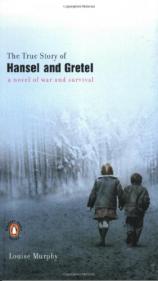About the Book
About the Book
The True Story of Hansel and Gretel

"The story has been told over and over by liars and it must be retold."
In the winter of 1943, on the outskirts of a dark forest, two Jewish children flee the Nazis with their father and stepmother. In a moment of desperation, the children are given the aliases Hansel and Gretel and sent alone into the woods to hide. Gretel leads her younger brother in search of food and protection, while Hansel leaves a trail of breadcrumbs behind so that their father might find them again. So begins The True Story of Hansel and Gretel, which takes us along on their journey into a forest more ancient than man. In a landscape populated by exotic beasts, refugees, and revolutionaries, the two children embark upon a new life as Christian orphans, protected by a woman who is called Magda the witch and whose tiny hut is heated by an enormous baker's oven.
In this extraordinary novel by Louise Murphy, a fairy tale is reimagined and a war story retold. It is the story of individuals striving to survive and a village trying to outlast a war. Magda the witch lives on the edge of Piaski, in a region of Eastern Poland that has been overrun first by Russians and now by Germans. Her family is an assortment of outsiders: her brother Piotr, a fallen priest, her great-niece Nelka, a beauty in love with an enigmatic woodsman, her dead grandmother, a Gypsy and an abortionist. The villagers are terrorized by a small but vicious Nazi presence and weary at the end of a war that has brought them many conquerors and few saviors. Murphy unflinchingly presents the war as a landscape of horrors, the village humiliated under the yoke of ruthless SS officers and by the necessities of survival under unbearable circumstances.
We also follow the trials of Hansel and Gretel's father, who endures a brutal winter of revolutionary action and personal transformation, all the while preoccupied with the fear that his children may not survive and the hope that he will find them again. This unique novel gives voice to figures that have before now been underrepresented in the writing of World War II: the voices of Jews who hid in the forests, of men and women who participated in resistance movements, and of Polish civilians. These characters struggle with their relationship with God, with their disgust for a humanity in crisis, and with the desire to define a new and more just world.
Yet Murphy manages to maintain the fairy-tale foundation of her story, returning again and again to the elements of an old story to infuse meaning into a newer one. The Bialowieza Forest, the oldest in Europe, is a place of mysterious and untouched beauty, and its lessons for the children and for humanity permeate the book. Murphy juxtaposes horror with lyricism, reality with magic. The primal nature of war is met by the primal power of story—and the belief that love can rescue humans from their worst capabilities. Hansel and Gretel are on a quest to reclaim their identities, and the witch and the forest—the world of the fairy tale—show them the way.
In prose both luminous and enlightening, Murphy explores the power of memory, the necessity of love in times of great trauma, and the redemption that can come about through the refusal to erase one's own past. This is the tale of two brave children who never give up, of women who refuse to be defined by convention, and of the bitter cost of survival. Over the course of the winter, Hansel and Gretel will come of age. Their mother dead, their father and stepmother in hiding, by necessity forced to alter their own identities, they become survivors.
The True Story of Hansel and Gretel
- Publication Date: July 29, 2003
- Paperback: 297 pages
- Publisher: Penguin (Non-Classics)
- ISBN-10: 0142003077
- ISBN-13: 9780142003077







